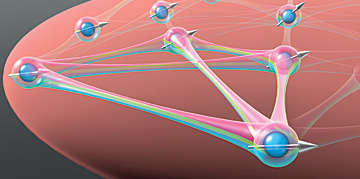Researchers at the National Institute of Standards and Technology (NIST) have developed a new microscope able to view and measure an important but elusive property of the nanoscale magnets used in an advanced, experimental form of digital memory. The new instrument already has demonstrated its utility with initial results that suggest how to limit power consumption in future computer memories.
Animation of spin waves excited by a transient magnetic field pulse in a nanomagnet, as simulated with NIST micromagnetics software (Object Oriented MicroMagnetic Framework, or OOMMF). Credit: Boone/NIST
NIST’s heterodyne magneto-optic microwave microscope, or H-MOMM, can measure collective dynamics of the electrons’ spins, the basic phenomenon behind magnetism, in individual magnets as small as 100 nanometers in diameter. Nanomagnets are central components of low-power, high-speed “spintronic” computer memory, which might soon replace conventional random-access memory. Spintronics relies on electrons behaving like bar magnets, pointing in different directions to manipulate and store data, whereas conventional electronics rely on charge.
“The measurement technique is entirely novel, the capability that it has enabled is unprecedented, and the scientific results are groundbreaking,” said project leader Tom Silva.
NIST researchers used the H-MOMM to quantify, for the first time, the spin relaxation process, or damping, in individual nanomagnets. Spin relaxation is related to how much energy is required to switch a unit of spintronic memory between a 0 and a 1 (the bits used to represent data).
The nanomagnets used in experimental spintronic systems are too big to yield their secrets to conventional atomic physics tools yet too small for techniques used with bulk materials. Until now, researchers have been forced to measure the average damping from groups of nanomagnets. The new microscope enabled NIST researchers to study, in detail, the ups and downs of spin excitation in individual magnets made of a layer of a nickel-iron alloy on a sapphire base.
The H-MOMM combines optical and microwave techniques. Two green laser beams are merged to generate microwaves, which excite “spin waves”—magnetic oscillations that vary with position across an individual nanomagnet, like waves in a bathtub. Polarized light from one laser is used to analyze the excitation pattern. By measuring excitation as a function of magnetic field and microwave frequency, researchers can deduce the damping of various spin waves in each nanomagnet.
Measurement and control of magnetic damping is crucial for spintronics, because the smaller the damping, the less energy is required to store a bit of data, and the less power a device requires to operate. The NIST study suggests that designing spintronic devices to have uniform spin waves could dramatically reduce the energy required to write a bit.
The new microscope is one outcome of an ongoing NIST effort to develop methods for measuring defects in magnetic nanostructures. At extremely small scales, defects dominate and can disrupt magnetic device behavior, resulting in errors in reading and writing information.



